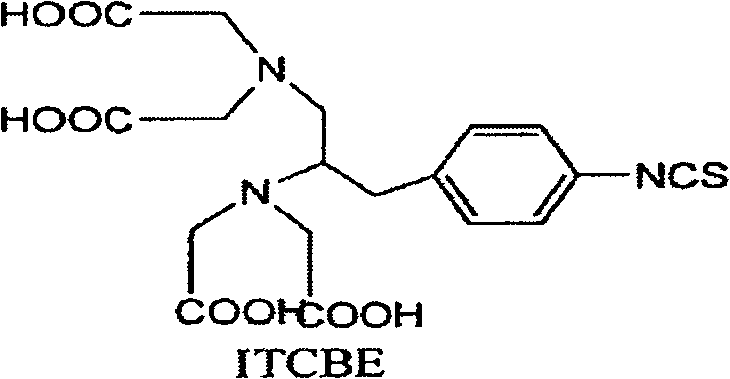Antibody against heavy metal cadmium and application of same in detection of cadmium residue in traditional Chinese medicine
A technology of heavy metals and antibodies, applied in measuring devices, instruments, scientific instruments, etc., can solve the problems of tedious and time-consuming sampling, transportation and storage, and limited selection of complexing agents, and achieve good sensitivity, good application prospects, and stable antibodies Effect
- Summary
- Abstract
- Description
- Claims
- Application Information
AI Technical Summary
Problems solved by technology
Method used
Image
Examples
Embodiment 1
[0051] 1. Antigen design and synthesis
[0052] Using bifunctional chelating agent isothiocyanate benzylethylenediaminetetraacetic acid (ITCBE) to couple heavy metal cadmium ions to keyhole limpet hemocyanin (KLH), the specific method is:
[0053] Weigh 1.4 mg ITCBE and dissolve it in 1 mL DMSO, slowly add 710 μL of 1000 mg / L cadmium solution standard into the ITCBE solution dropwise, adjust the pH to 7.4 with triethylamine, and stir for 24 hours at 25 °C with a magnetic stirrer. 10mg KLH was dissolved in 20mmol / L Hepes buffer solution, and the above-mentioned chelated reaction solution was slowly added dropwise to the KLH solution, and the pH was adjusted to 9.6 with triethylamine. After stirring with a magnetic stirrer for 24 h at 25° C., it was dialyzed with 5 mmol / L HEPES buffer solution for three days.
[0054] 2. Preparation of Coating Antigen
[0055] Using bifunctional chelating agent isothiocyanate benzylethylenediaminetetraacetic acid (ITCBE), the heavy metal cadmi...
PUM
 Login to View More
Login to View More Abstract
Description
Claims
Application Information
 Login to View More
Login to View More - R&D
- Intellectual Property
- Life Sciences
- Materials
- Tech Scout
- Unparalleled Data Quality
- Higher Quality Content
- 60% Fewer Hallucinations
Browse by: Latest US Patents, China's latest patents, Technical Efficacy Thesaurus, Application Domain, Technology Topic, Popular Technical Reports.
© 2025 PatSnap. All rights reserved.Legal|Privacy policy|Modern Slavery Act Transparency Statement|Sitemap|About US| Contact US: help@patsnap.com


